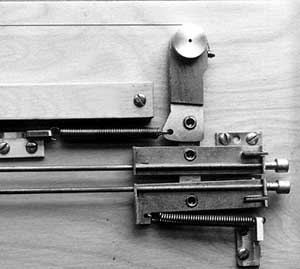
 |
|---|
The Sho-Bud guitars made around 1970 used a pulling system composed of a "rack" and a "barrel." The rack consisted of two sheet metal stampings that swiveled on two parallel bell-cranks. Each stamping had ten holes in it which would allow a 1/8" rod to pass through. (see the partially turned rack in the left foreground on photo to right.)
 |
|---|
The rods came through the changer and then through all the racks attached to the neck. All that was needed to facilitate a change was to place a "barrel" on the rod at the rack which was activated by the pedal or knee lever.
The brass barrel was made of three pieces: The body, the tuner, and the spring. The body was threaded to allow the tuner to screw in and out. The tuner had a hole in the front through which a piece of the compression spring extended.
 |
|---|
To tune the pedal change, the pedal was pressed, moving the rack back against the barrel. Then the rod was turned by the socket at the end of the rod. Since the barrel was held to the rod by a set screw, the whole unit turned until the protruding spring came up against the rack. At this point, further turning the rod simply screwed the tuner in and out, adjusting the length of the rod.
The beauty of the system was that any pedal could move any string any amount. Just put a barrel on the rod in the appropriate place. It was the ideal guitar on which to experiment with pedal/ knee lever changes.